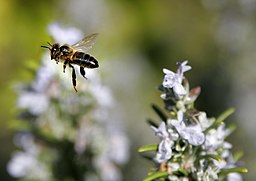Declining Honeybee Populations
In recent years, the honeybee population has been declining. This is deeply concerning because of the important role that bees play in the pollination of our crops and food. One in three mouthfuls of food that we eat everyday is the result of the work of the honeybee. These small creatures are responsible for producing $170 billion crops every year, providing us with food and creating the livelihood of many. While the causes for the deaths of these bees vary, climate change is one of the major issues associated with them. The United States’ honeybee population has decreased by about 45 percent between 2020 and 2021, and the impact of this issue has prompted discourse about the population decline. This is not a particularly new issue, but now that it has become more serious many scientists and scholars are participating in discourse and “ecospeak” to raise awareness and discuss the causes and repercussions of this issue. This discourse has developed and changed over time, as evidenced by the differences between older and more recent articles. Participation in the discourse surrounding declining honeybee populations is guided by the cultural units that people are a part of. These cultural units shape and inform world view and impact the ways in which we discuss important topics.
A Beekeeper's Perspective
In the 2013 article “The Plight of the Honeybee”, published in Time Magazine, Bryan Walsh raises the issue of honeybees dying at a rapid rate. He looks back to 2006, when the issue first began to cause alarm, and writes about the issues and information that has been learned since then. Walsh comes to the discourse from a particularly interesting place as someone who is a beekeeper. Because of this, he has first hand knowledge of the honeybees’ disappearance and decline. He addresses the multiple culprits — viruses and pesticides with harmful chemicals — before eventually settling on the larger issue that is climate change. Walsh discusses in depth the various causes for the decline of the honeybee population, beyond simply climate change. The main focus of his article is the importance of honeybees to humans and the way that farmers and beekeepers are affected by the deaths of honeybees. This shows his background as he comes to the discourse surrounding this issue. Walsh belongs to a cultural unit of beekeepers, and this informs his participation in discourse. He views the honeybees through an ethnocentric lens, with a view of nature as a resource because honeybees are directly connected to beekeepers' agricultural success, (Herndl and Brown 11).A Scholarly Perspective
In a 2017 article that was updated in 2022, “The Buzz on Climate Change: It’s Bad for Bees”, Leah Duran, a professor at the University of Arizona, raised the issue of the declining honeybee population once again. Her article was posted on Conservation.org, a website that has the specific goal of raising awareness about environmental issues. The discourse Duran presents is clearly outlined, as if for the general public to understand. She outlines three main causes for the rapid decline of the honeybee population: habitat loss, shifting temperatures, and disease. In listing these three factors, she clearly explains to the reader the reasons that climate change is negatively affecting the honeybees, preventing them from migrating to cooler areas to establish new hives, disrupting their pollination schedule, and making them more vulnerable to parasites and infections.Duran participates in the discourse surrounding the declining honeybee population by contributing to the conversation and making it more accessible to the average person. She simply highlights the key issues, explaining them in basic language that anyone could understand. But beyond providing her readers with information, she also instructs others on what they might do to help save the honeybees. Duran encourages her readers to plant gardens, and in doing so she not only gives her own take and advice on the issue, but also urges others to participate in the discourse. She encourages her readers to do something that will positively impact the environment and the honeybees, thus encouraging them to become involved in creating their own discourse and further spreading the message of the declining honeybee population. Duran belongs to a cultural unit of professors and scholars and she participates in discourse about declining honeybee populations from an ecocentric perspective, viewing nature as a spirit, (Herndl and Brown 11).


Comments
Post a Comment